Granular Physics |
| Dynamics
|
Granular materials flow like complex fluids
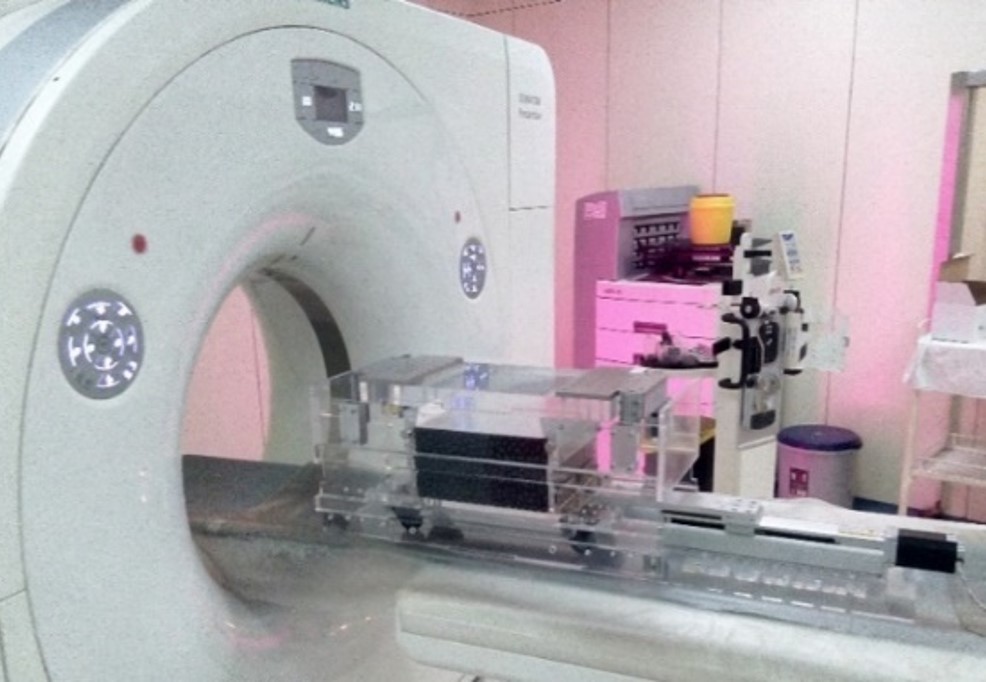
|
Static granular packings are structurally similar to molecular and atomic glassy materials. In the past, it is generally believed that the microscopic dynamics and mechanical properties should be analogous too. Here we use X-ray tomography to determine the microscale relaxation dynamics of hard granular ellipsoids subject to an oscillatory shear. We find that the distribution of the displacements of the ellipsoids is well described by a Gumbel law (which is similar to a Gaussian distribution for small displacements but has a heavier tail for larger displacements), with a shape parameter that is independent of the amplitude of the shear strain and of the time. Despite this universality, the mean squared displacement of an individual ellipsoid follows a power law as a function of time, with an exponent that does depend on the strain amplitude and time. We argue that these results are related to microscale relaxation mechanisms that involve friction and memory effects. The work has been published on Nature, 551, 360–363(2017). ( PDF ) |
Equivalence of Fluctuation-Dissipation and Edwards’ Temperature in Cyclically Sheared Granular Systems
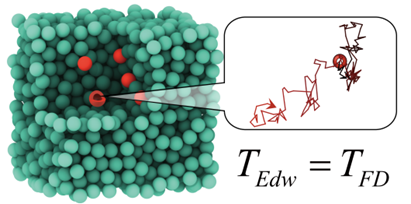
|
Granular matter, which is an achetypical disordered system ubiquitous in nature and engineering processes, needs a statistical mechanics framework that allows the definition of an effective temperature. Using particle trajectory data obtained from x-ray tomography, we determine two kinds of effective temperatures in a cyclically sheared granular system. The first one is obtained from the fluctuation-dissipation theorem which relates the diffusion and mobility of lighter tracer particles immersed in the system. The second is the Edwards compactivity defined via the packing volume fluctuations. We find robust agreement between these two temperatures, independent of the type of the tracers, cyclic shear amplitudes, and particle surface roughness, giving therefore the first experimental evidence that the concept of effective temperature is valid in driven frictional granular systems. The work has been published on Phys. Rev. Lett., 129, 228004 (2022). ( PDF ) |
Microscopic structure and dynamics study of granular segregation mechanism by cyclic shear
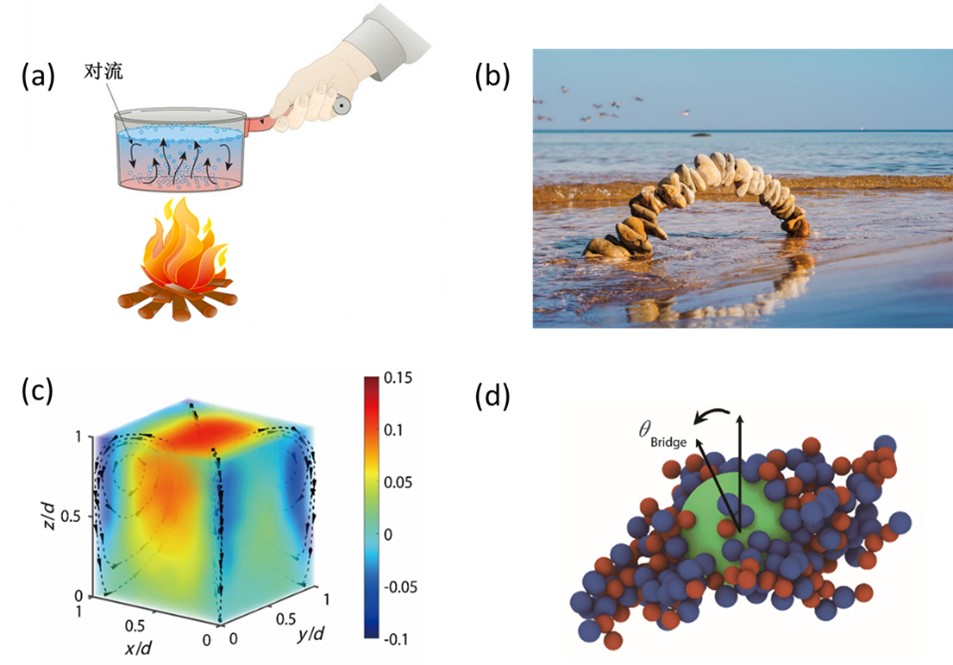
|
Granular segregation often occurs in the process of handle granular matter in industry or in some natural disasters and geophysical process, for example, landslide, debris flow and so on.In this study,the researchers used 3D CT imaging technology to study the segregation of the granular system under cyclic shear. It was found that the convection and arching effect were play important roles on the granular segregation in the granular system under cyclic shear. And by analyzing the microstructure and dynamics of the particle system, the specific physical processes of the two effects were given. The results of this research will deepen our understanding of the segregation mechanism of granular matter. The work has been published on Science Advance, 7, eabe8737(2021). ( PDF ) |
Structural and topological nature of plasticity in sheared granular materials
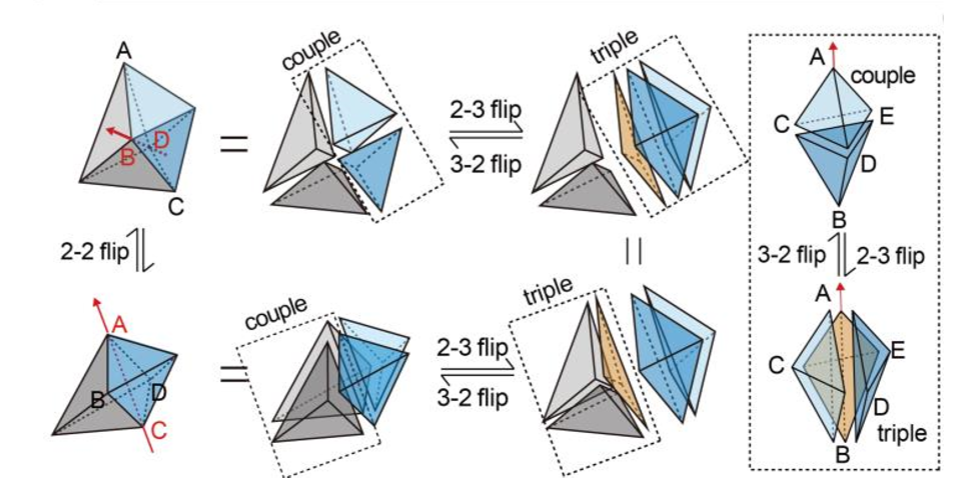
|
Granular materials yield and undergo plastic deformation upon mechanical loading. However, we still do not fully understand the microscopic nature of plastic deformation in disordered granular materials. The plasticity of crystals can be understood by the properties of dislocations. In non-crystalline systems, whether there exists certain kind of “defect” that is similar to dislocation has been the research focus in the past. We carried out an in-situ X-ray tomography study to obtain the structural evolution of the three-dimensional granular system upon shear. We found that the plastic carrier in amorphous system is another type of topological defect associated with rotational degrees of freedom, very similar to dislocation, which is the topological defect of translational degrees of freedom. The results demonstrates that the symmetry breaking of glass transition happens in the rotational degrees of freedom instead of the translational one. The work has been published on Nature Communications, 9, 2911(2018). ( PDF ) |
Glass order in granular packings
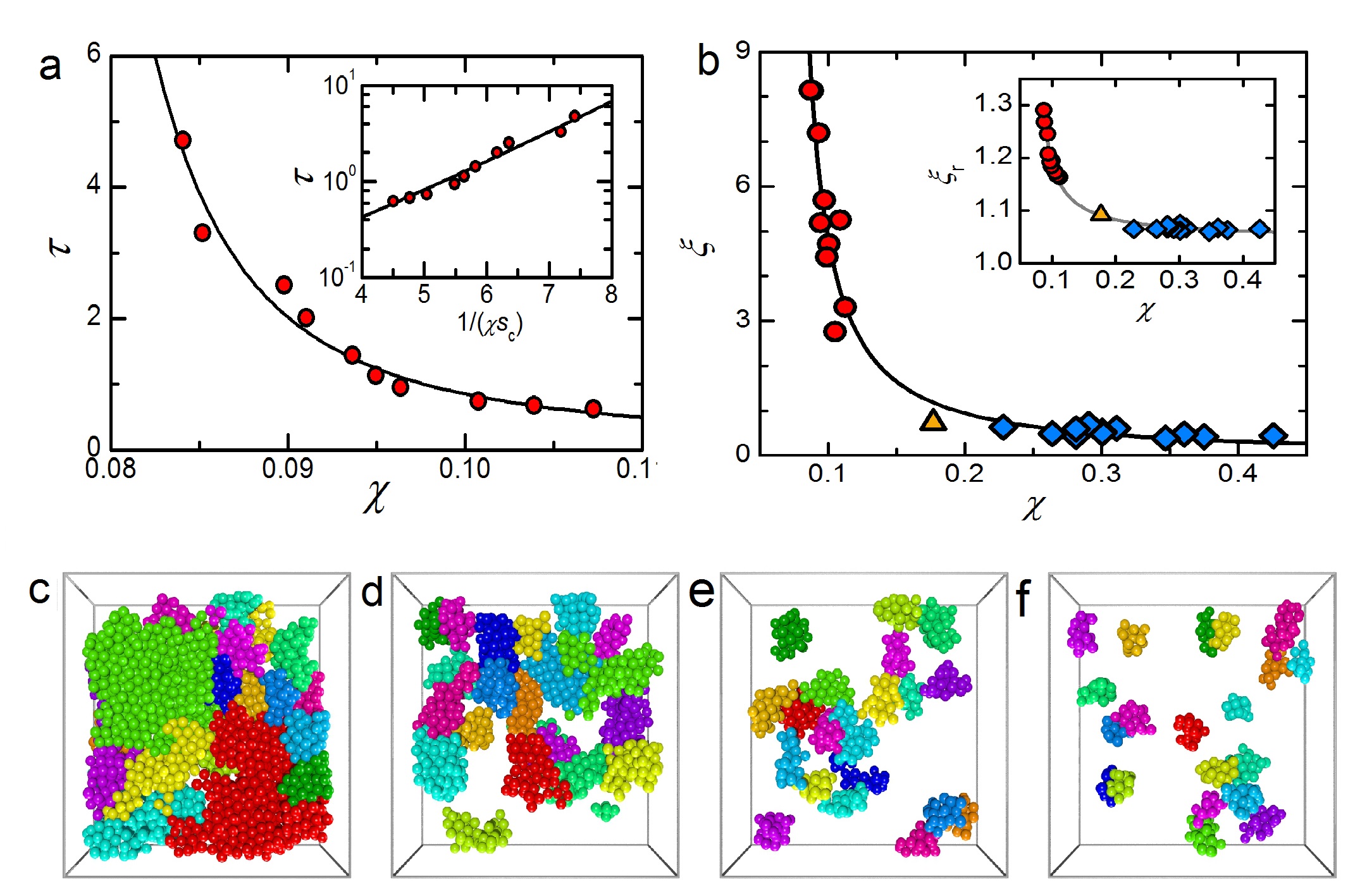
|
Spherical granular packing under vertical tapping, as an experimental system of hard-sphere glass, is studied systematically. The microscopic structural evolution of the packing is studied using up to 100 CTs of the packing during tapping processes. We define quasi-regular tetrahedral structures as a structural order parameter, which has five-fold symmetry and a fractal nature, thus cannot tile space. These tetrahedral structures are also correlated with the slow dynamics. In addition, the correlation length of tetrahedral structures grows as packing fraction increases, which follows an entropy-driven nucleation model. This research demonstrated that hard-sphere glass transition may be a special kind of crystallization, which is a structural thermodynamic phase transition. The work has been published on Nature Communications 6, 8409 (2015). ( PDF ) |
Translational and Rotational Dynamical Heterogeneities in Granular Systems
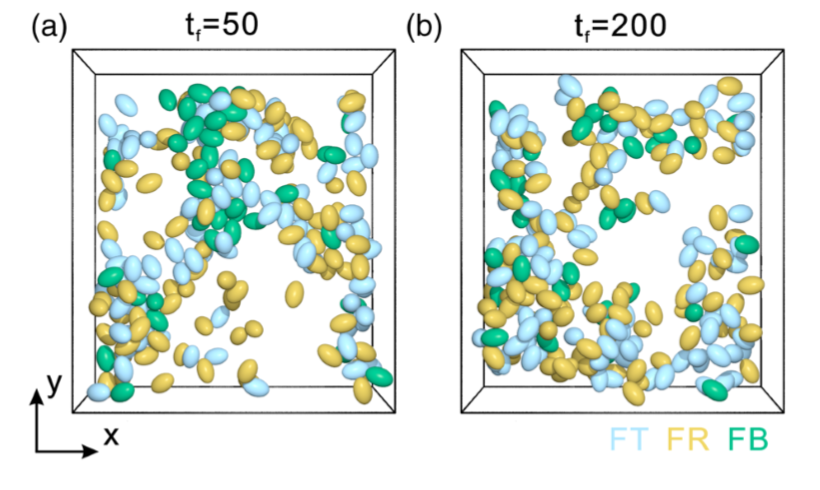
|
The dynamics of disordered systems exhibits strong inhomogeneities in space and time, a phenomenon that is called “dynamic heterogeneity”. In the past, the study of dynamic heterogeneity was generally limited to the translational degrees of freedom whereas little is known so far about the behavior of the rotational degrees of freedom. In addition to the influence of the shape of the particles , the existence of friction in granular systems enhances the coupling of translational and rotational degrees of freedom, which makes the understanding of the dynamics of rotational degrees of freedom especially important.To advance on the question of this coupling we use X-ray tomography to determine the translational and rotational dynamical heterogeneities of a three dimensional hard ellipsoid granular packing driven by oscillatory shear. The work has been published on Phys. Rev. Lett., 121, 018002 (2018). ( PDF ) |
X-ray microtomography study of the compaction process of rods under tapping
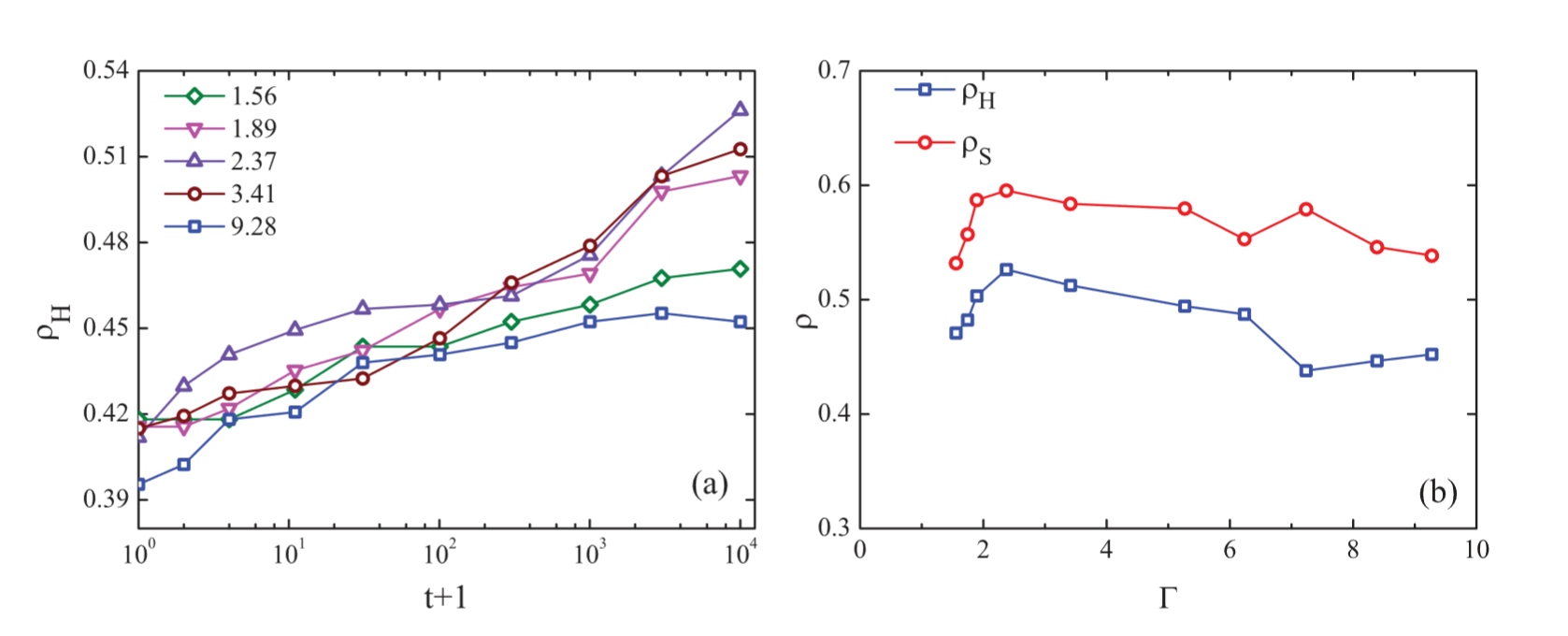
|
Packing of rods evolve from isotropic phase towards nematic phase under external vertical tapping. It is demonstrated that the relaxation time of the system obeys an Arrhenius law in which the tapping intensity plays the role of the effective temperature. It is thus suggested that the macroscopic behavior of non-thermal granular system can be descried using some thermodynamic quantities, and its relaxation time is very similar to the aging process of glass systems. The work has been published on Phys. Rev. E 85, 051311 (2012). ( PDF ) |
Effective temperature in a vibrated granular medium

|
The flow state of granular system can be tuned by increasing vibration intensity from closing to the jamming state to a dense flow. The motion of tracking particles are analyzed using ultra-fast synchrotron X-ray imaging techniques. The viscosity and diffusion constant are calculated, and the effective temperature is hereafter derived using the fluctuation-dissipation theorem. It is demonstrated that the relaxation time increases rapidly as the system approaches the jamming transition. The characteristic energy scale obtained using Arrhenius fitting in our system is consistent with previous works on hard sphere model, suggesting that the relaxation process in granular system is taken place by creating free volume against external pressure. The work has been published on Soft Matter 10, 5398 (2014). ( PDF ) |
| Structure
|
Experimental test of the Edwards volume ensemble for tapped granular packings
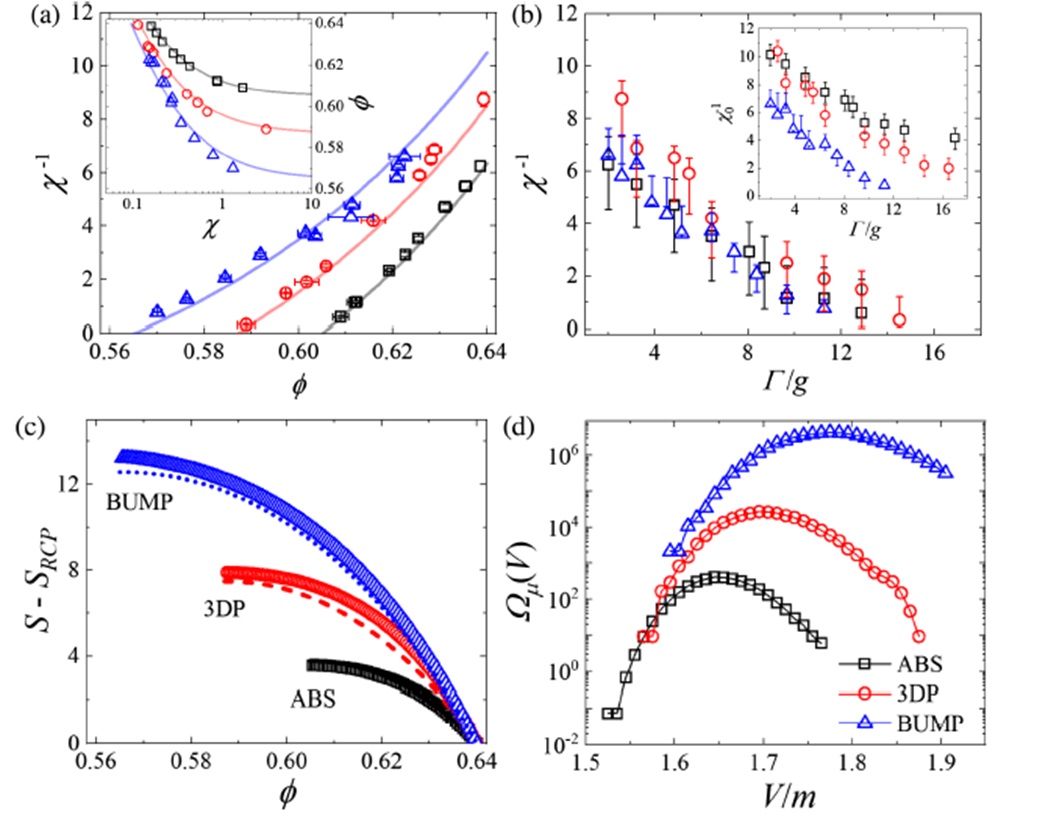
|
There are inelastic collisions and frictions between the constituent particles of the macroscopic particle system, and they always maintain a mechanically stable state without external driving. Therefore, particulate matter is a non-equilibrium multi-body system, which cannot be described by classical equilibrium statistical physics. However, when particulate matter is subjected to constant external excitation (such as vibration or cyclic shear), it always exhibits properties similar to the equilibrium state. In the 1990s, Professor S. F. Edwards of the University of Cambridge and his collaborators proposed an ensemble framework of statistical mechanics for particulate matter, which has become a long-term research hotspot in related fields. The research group combined with a 3D printer to prepare three spherical particle samples with different friction coefficients, and then used CT imaging technology to study their steady-state accumulation structure under different vibration intensit The work has been published on Phys. Rev. Lett. 127, 018002 (2021). ( PDF ) |
X-Ray Tomography Investigation of Cyclically Sheared Granular Materials
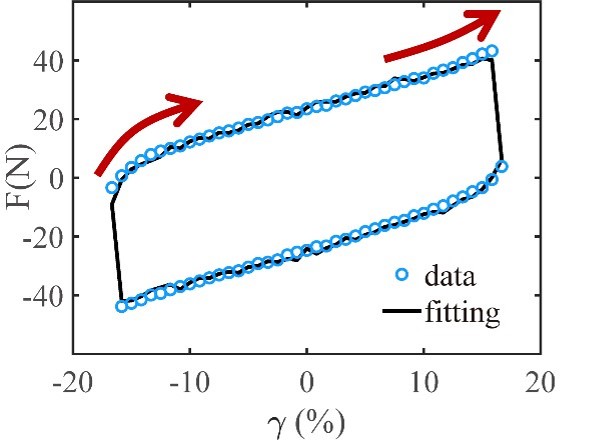
|
Understanding of dense granular flows is difficult not only due to the disordered nature of the system, but also the complex role played by friction. Most existing theories are empirical constitutive theories which lack microscopic basis and encounter great difficulties in applications. We perform combined X-ray tomography and shear force measurements on a cyclically sheared granular system with highly transient behaviors, and obtain the evolution of microscopic structures and the macroscopic shear force during the shear cycle. We explain the macroscopic behaviors of the system based on microscopic processes, including the particle level structural rearrangement and frictional contact variation. Specifically, we show how contact friction can induce large structural fluctuations and cause significant shear dilatancy effect for granular materials, and we also construct an empirical constitutive relationship for the macroscopic shear force. The work has been published on Phys. Rev. Lett. 126, 048002(2021). ( PDF ) |
Connecting Packing Efficiency of Binary Hard Sphere Systems to Their Intermediate Range Structure
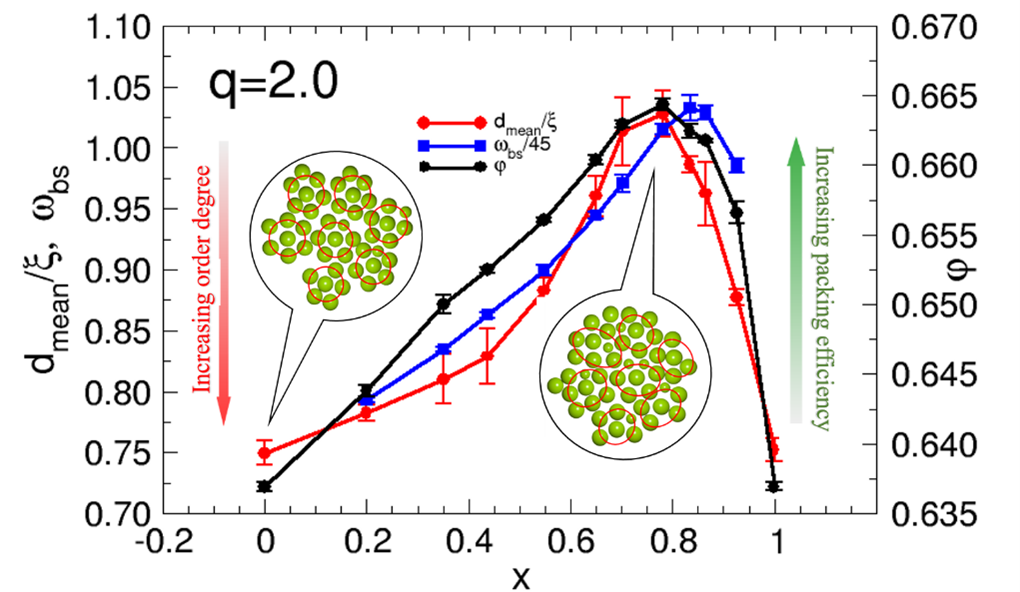
|
Granular packs formed by grains, sand, pebbles, etc. are important not only in civil engineering (roads, dams,...) or geosciences (landslides,...), but also in the chemical industry that uses powders of all kinds. In the present work we have employed computational X-ray tomography, the technique used to scan human bodies, to determine the three dimensional structure of a pile of hard spheres. By employing a novel method to analyse this structure we have been able to show that the arrangement of the particles is in fact much less disordered than expected in that one finds spatial correlations that extend to surprisingly large distances. Furthermore our experiments reveal the presence of symmetries in the structure, a type of order that has not been detected in any previous experiments or theoretical calculations. Our measurements demonstrate that in order to have a maximally dense packing of the pile, the structural correlation has to be small, or in other words, the densest packings are the ones that are maximally disordered Phys. Rev. Lett. 127, 278001(2021). ( PDF ) |
Structures of wet granular packings
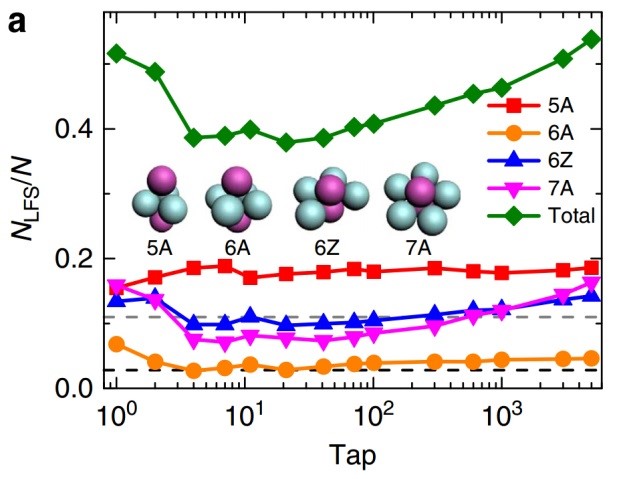
|
Wet granular packings is a model system for attractive glass, since the liquid bridges between particles induce an effective attraction interaction. Lots of locally-prefered-structures with five-fold symmetry are found in short range, which is similar to colloidal system and shows significant difference with dry granular packings. This work suggested that dynamic arrest may be due to geometrical frustrations in both thermal and non-thermal systems. In contrary, pair correlations evolve slightly during compaction, suggesting that higher-order correlations play more important role in glass transition in our systems. The work has been published on Nature Communications 5, 5014 (2014). ( PDF ) |
Bridge structures in granular packings
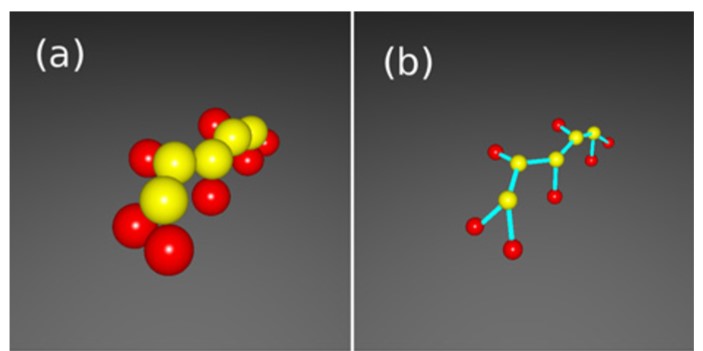
|
Static granular packing has an amorphous liquid-like structure while it can hold some stress like a solid. It’s important to understand the origin of the rigidity of amorphous solids. A bridge structure was defined by A. Mehta and coworkers, which was thought to be related with force chains inside the packing. We observed the bridge structures in experimental 3D packings, with all characteristic parameters consistent with numerical results. Studying these bridge structures in packings with different packing fractions helps to understand the jamming phenomenon, and a possible structural origin of amorphous solid rigidity. The work has been published on Europhys. Lett., 102, 24004 (2013). ( PDF ) |
Angularly anisotropic correlation in granular packings
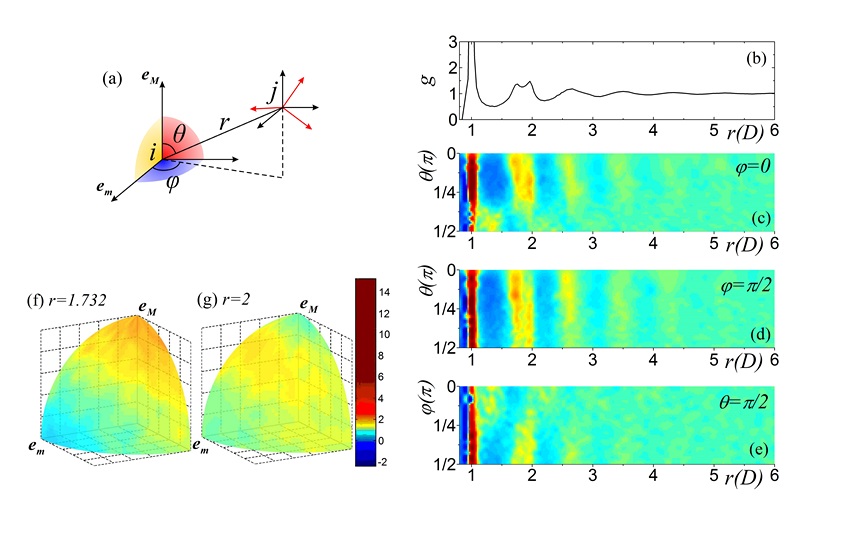
|
This research focuses on the multi-particle correlations in static mono-dispersed sphere packings. It’s demonstrated that the common pair correlation function can be decomposed into translational and orientational parts, while the correlation is locally anisotropic. In addition, this anisotropy majorly originated from some local structures with five-fold symmetry, which are similar to the locally preferred structures in some molecular systems. The work has been published on Phys. Rev. E 90, 062201(2014). ( PDF ) |
Random packing structures of ellipsoids
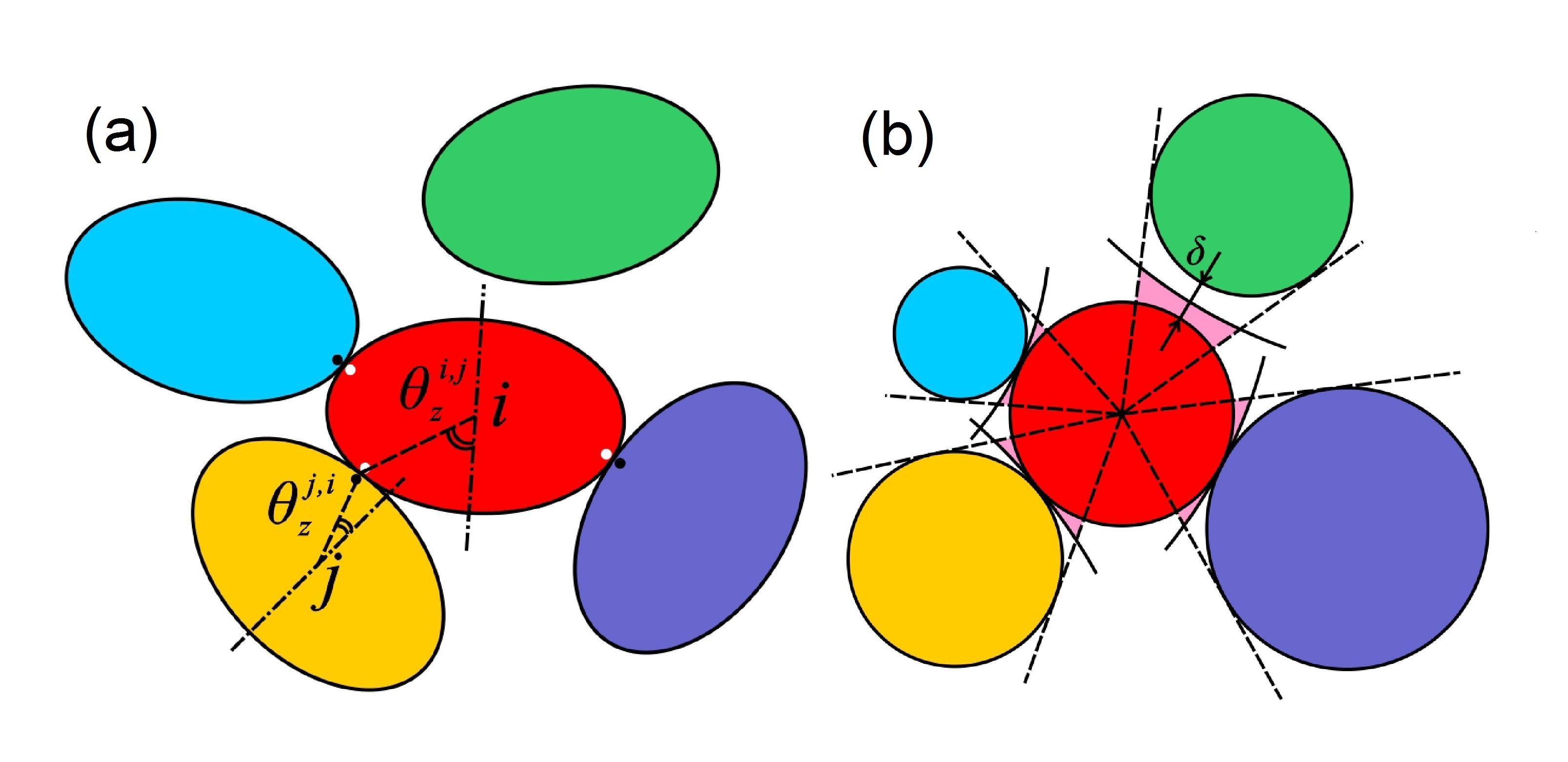
|
The random packing structures of ellipsoid packing are obtained using medical CT. We found that the particle non-spherical effect induce an effective polydispersity, and the non-spherical packing can be mapped onto a polydispersed spherical packing. In addition, the asphericity or polydispersity reduces the correlation of the packing, the local packing structure of which can thus be described using a mean-field model, i.e., the granocentric model. The work has been published on Soft Matter 10, 990 (2014). ( PDF ) |
Packing structures of rods with different aspect ratios
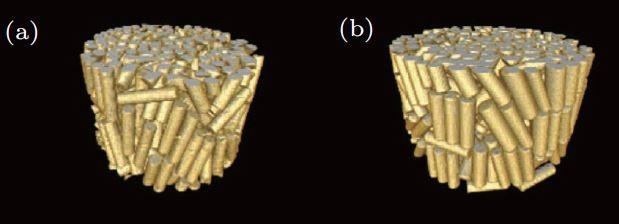
|
Packing of rods with different aspect ratios is studied using synchrotron X-ray in-line phase contrast imaging techniques. The relationships between local packing structures, i.e., contact number and free volume, and particle shape is analyzed. The work has been published on Chinese Phys. B 23, 044501 (2014). ( PDF ) |
